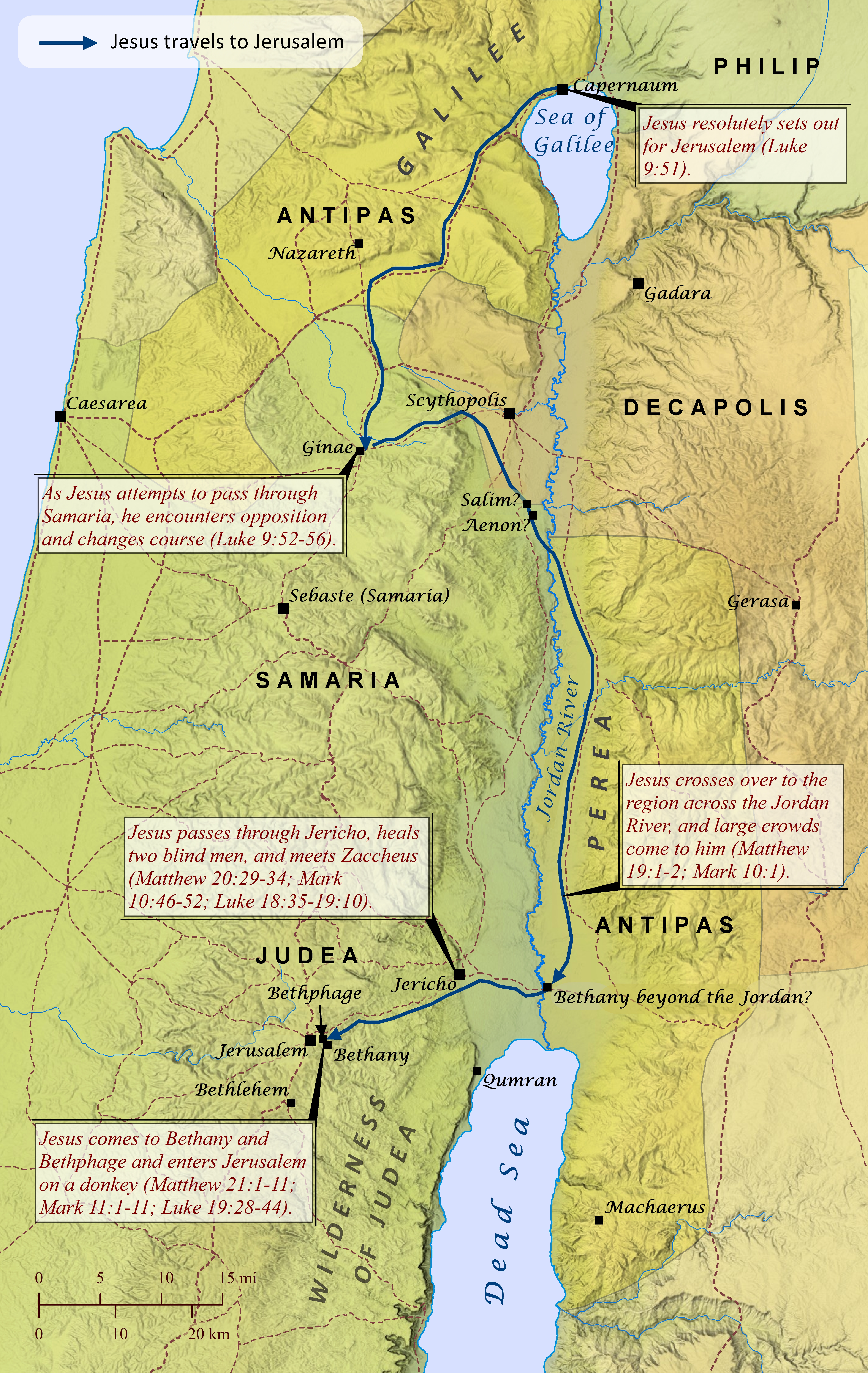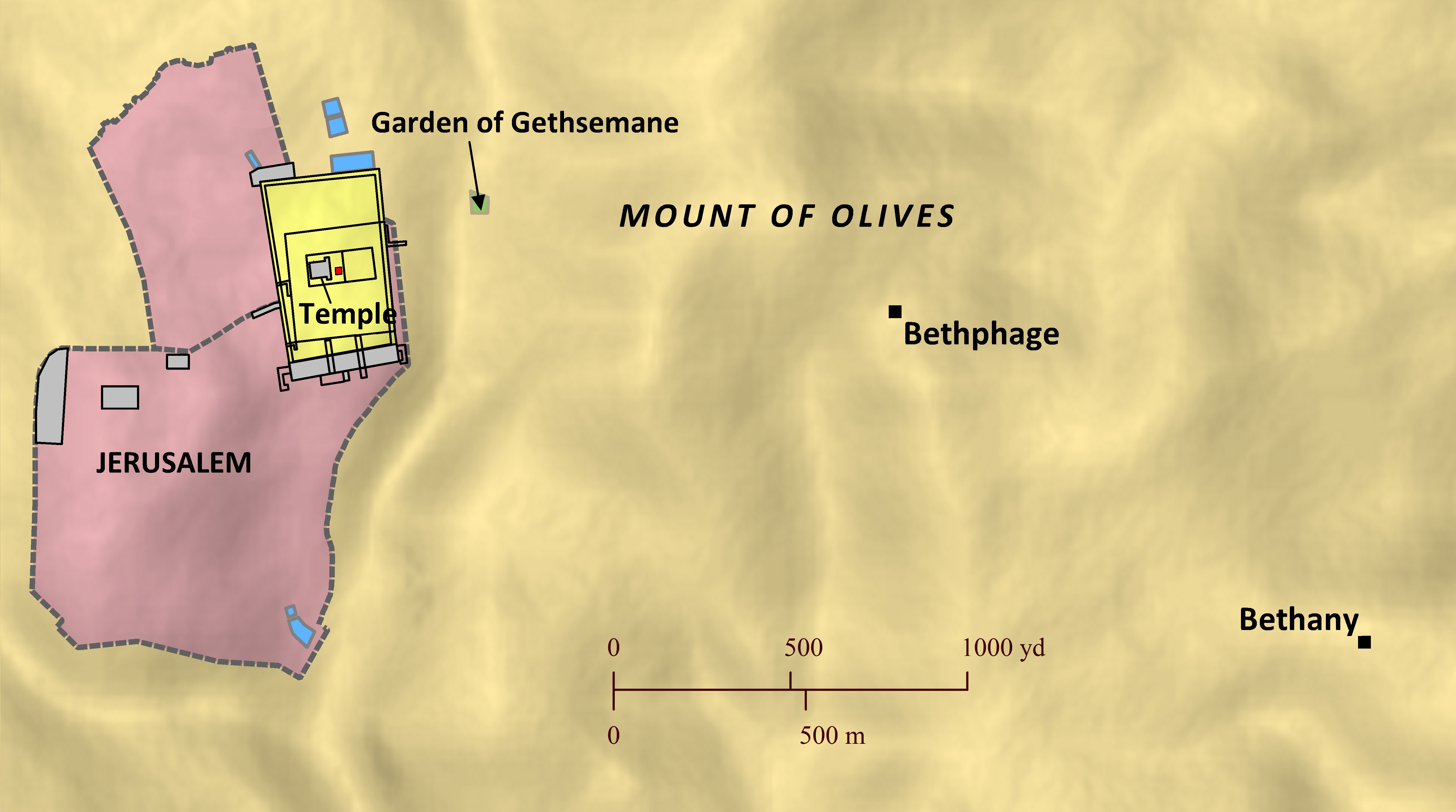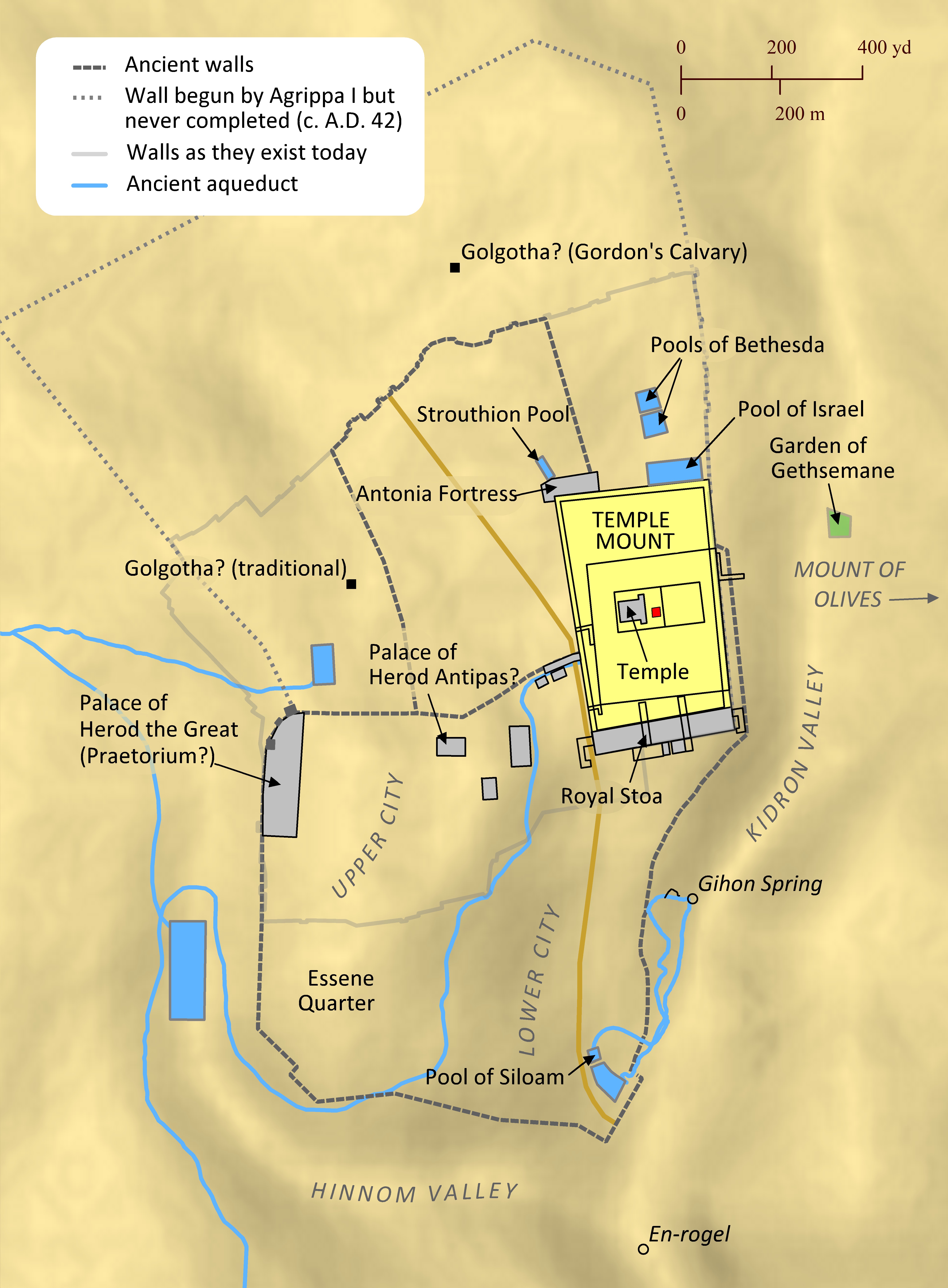Note: This view shows ‘verses’ which are not natural language units and hence sometimes only part of a sentence will be visible—click on any Bible version abbreviation down the left-hand side to see the verse in more of its context. Normally the OET discourages the reading of individual ‘verses’, but this view is only designed as a tool for doing comparisons of different translations—the older translations are further down the page (so you can read up from the bottom to trace the English translation history). The OET segments on this page are still very early looks into the unfinished texts of the Open English Translation of the Bible—please double-check these texts in advance before using in public.
AICNT And when they approached Jerusalem and came to Bethphage at the Mount of Olives, then Jesus sent two disciples,
OEB When they had almost reached Jerusalem, having come as far as Bethphage, on the Mount of Olives, Jesus sent on two disciples.
WEBBE When they came near to Jerusalem and came to Bethsphage,[fn] to the Mount of Olives, then Jesus sent two disciples,
WMBB When they came near to Jerusalem and came to Bethsphage,[fn] to the Mount of Olives, then Yeshua sent two disciples,
NET Now when they approached Jerusalem and came to Bethphage, at the Mount of Olives, Jesus sent two disciples,
LSV And when they came near to Jerusalem, and came to Bethphage, to the Mount of Olives, then Jesus sent two disciples,
FBV Jesus and his disciples went to Jerusalem. As they were getting close, they came to the village of Bethphage on the Mount of Olives. Jesus sent two disciples on ahead,
TCNT When they drew near to Jerusalem and came to [fn]Bethsphage, at the Mount of Olives, Jesus sent two disciples ahead,
T4T 1-2 As we approached Jerusalem, we came near Bethphage village, near Olive Tree Hill. Jesus said to two of his disciples, “Go to the village just ahead of us. As soon as you enter it, you will see a donkey and her foal that are {someone has} tied up. Untie them and bring them here to me.
LEB And when they drew near to Jerusalem and came to Bethphage at the Mount of Olives, then Jesus sent two disciples,
BBE And when they were near Jerusalem, and had come to Beth-phage, to the Mountain of Olives, Jesus sent two disciples,
Moff When they came near Jerusalem and had reached Bethphage at the Hill of Olives, then Jesus despatched two disciples,
Wymth When they were come near Jerusalem and had arrived at Bethphage and the Mount of Olives, Jesus sent two of the disciples on in front,
ASV And when they drew nigh unto Jerusalem, and came unto Bethphage, unto the mount of Olives, then Jesus sent two disciples,
DRA And when they drew nigh to Jerusalem, and were come to Bethphage, unto mount Olivet, then Jesus sent two disciples,
YLT And when they came nigh to Jerusalem, and came to Bethphage, unto the mount of the Olives, then Jesus sent two disciples,
Drby And when they drew near to Jerusalem and came to Bethphage, at the mount of Olives, then Jesus sent two disciples,
RV And when they drew nigh unto Jerusalem, and came unto Bethphage, unto the mount of Olives, then Jesus sent two disciples,
(And when they drew nigh unto Yerusalem, and came unto Bethphage, unto the mount of Olives, then Jesus sent two disciples, )
SLT And when they drew near to Jerusalem, and came to Bethphage, to the mount of Olives, then sent Jesus two disciples, saying to them,
Wbstr And when they drew nigh to Jerusalem, and had come to Bethphage, to the mount of Olives, then Jesus sent two disciples,
KJB-1769 And when they drew nigh unto Jerusalem, and were come to Bethphage, unto the mount of Olives, then sent Jesus two disciples,
(And when they drew nigh unto Yerusalem, and were come to Bethphage, unto the mount of Olives, then sent Jesus two disciples, )
KJB-1611 ¶ And when they drewe nigh vnto Hierusalem, and were come to Bethphage, vnto the mount of Oliues, then sent Iesus two Disciples,
(Modernised spelling is same as from KJB-1769 above, apart from capitalisation and punctuation)
Bshps And when they drewe nye vnto Hierusalem, & were come to Bethphage, vnto the mout of Oliues, the sent Iesus two disciples,
(And when they drew nigh/near unto Yerusalem, and were come to Bethphage, unto the mount of Olives, the sent Yesus/Yeshua two disciples,)
Gnva And when they drewe neere to Hierusalem, and were come to Bethphage, vnto the mount of the Oliues, then sent Iesus two disciples,
(And when they drew near to Yerusalem, and were come to Bethphage, unto the mount of the Olives, then sent Yesus/Yeshua two disciples, )
Cvdl Now whan they drew nye vnto Ierusalem, and were come to Bethphage vnto mount Oliuete, Iesus sent two of his disciples,
(Now when they drew nigh/near unto Yerusalem, and were come to Bethphage unto mount Olivet, Yesus/Yeshua sent two of his disciples,)
TNT When they drewe neye vnto Ierusalem and were come to Betphage vnto mounte olivete: then sent Iesus two of his disciples
(When they drew neye unto Yerusalem and were come to Betphage unto mounte Olivet: then sent Yesus/Yeshua two of his disciples )
Wycl And whanne Jhesus cam nyy to Jerusalem, and cam to Bethfage, at the mount of Olyuete, thanne sente he his twei disciplis, and seide to hem,
(And when Yhesus came nigh/near to Yerusalem, and came to Bethfage, at the mount of Olyuete, then sent he his twain/two_or_both disciples, and said to them,)
Luth Da sie nun nahe an Jerusalem kamen gen Bethphage an den Ölberg, sandte JEsus seiner Jünger zwei
(So they/she/them now near at/to Yerusalem came to/toward Bethphage at/to the oilberg, sent Yesus his disciple two)
ClVg Et cum appropinquassent Jerosolymis, et venissent Bethphage ad montem Oliveti: tunc Jesus misit duos discipulos,[fn]
(And when/with appropinquassent Yerosolymis, and they_would_have_come Bethphage to mountain Oliveti: then Yesus he_sent twos disciples, )
UGNT καὶ ὅτε ἤγγισαν εἰς Ἱεροσόλυμα καὶ ἦλθον εἰς Βηθφαγὴ πρὸς τὸ Ὄρος τῶν Ἐλαιῶν, τότε Ἰησοῦς ἀπέστειλεν δύο μαθητὰς
(kai hote aʸngisan eis Hierosoluma kai aʸlthon eis Baʸthfagaʸ pros to Oros tōn Elaiōn, tote Yaʸsous apesteilen duo mathaʸtas)
SBL-GNT Καὶ ὅτε ἤγγισαν εἰς Ἱεροσόλυμα καὶ ἦλθον εἰς Βηθφαγὴ ⸀εἰς τὸ Ὄρος τῶν Ἐλαιῶν, τότε ⸀Ἰησοῦς ἀπέστειλεν δύο μαθητὰς
(Kai hote aʸngisan eis Hierosoluma kai aʸlthon eis Baʸthfagaʸ ⸀eis to Oros tōn Elaiōn, tote ⸀Yaʸsous apesteilen duo mathaʸtas)
RP-GNT Καὶ ὅτε ἤγγισαν εἰς Ἱεροσόλυμα, καὶ ἦλθον εἰς Βηθσφαγὴ πρὸς τὸ ὄρος τῶν Ἐλαιῶν, τότε ὁ Ἰησοῦς ἀπέστειλεν δύο μαθητάς,
(Kai hote aʸngisan eis Hierosoluma, kai aʸlthon eis Baʸthsfagaʸ pros to oros tōn Elaiōn, tote ho Yaʸsous apesteilen duo mathaʸtas,)
TC-GNT Καὶ ὅτε ἤγγισαν εἰς Ἱεροσόλυμα, καὶ ἦλθον εἰς [fn]Βηθσφαγὴ [fn]πρὸς τὸ ὄρος τῶν Ἐλαιῶν, τότε [fn]ὁ Ἰησοῦς ἀπέστειλε δύο μαθητάς,
(Kai hote aʸngisan eis Hierosoluma, kai aʸlthon eis Baʸthsfagaʸ pros to oros tōn Elaiōn, tote ho Yaʸsous apesteile duo mathaʸtas, )
Key for above GNTs: yellow:punctuation differs, red:words differ (from our SR-GNT base).
BMM BibleMapper.com Maps:

Jesus’ Final Journey to Jerusalem
Much like the difficulties of discerning the Israelites’ journey to the Promised Land (see here), the task of reconciling the four Gospel accounts of Jesus’ final journey to Jerusalem into one coherent itinerary has proven very challenging for Bible scholars. As with many other events during Jesus’ ministry, the accounts of Matthew, Mark, and Luke (often referred to as the Synoptic Gospels) present a noticeably similar account of Jesus’ final travels, while John’s Gospel presents an itinerary that is markedly different from the others. In general, the Synoptic Gospels present Jesus as making a single journey to Jerusalem, beginning in Capernaum (Luke 9:51), passing through Perea (Matthew 19:1-2; Mark 10:1) and Jericho (Matthew 20:29-34; Mark 10:46-52; Luke 18:35-19:10), and ending at Bethany and Bethphage, where he enters Jerusalem riding on a donkey (Matthew 21:1-11; Mark 11:1-11; Luke 19:28-44). John, on the other hand, mentions several trips to Jerusalem by Jesus (John 2:13-17; 5:1-15; 7:1-13; 10:22-23), followed by a trip to Perea across the Jordan River (John 10:40-42), a return to Bethany where he raises Lazarus from the dead (John 11), a withdrawal to the village of Ephraim for a few months (John 11:54), and a return trip to Bethany, where he then enters Jerusalem riding on a donkey (John 12:1-19). The differences between the Synoptics’ and John’s accounts are noteworthy, but they are not irreconcilable. The Synoptics, after noting that Jesus began his trip at Capernaum, likely condensed their accounts (as occurs elsewhere in the Gospels) to omit Jesus’ initial arrival in Jerusalem and appearance at the Festival of Dedication, thus picking up with Jesus in Perea (stage 2 of John’s itinerary). Then all the Gospels recount Jesus’ trip (back) to Bethany and Jerusalem, passing through Jericho along the way. Likewise, the Synoptics must have simply omitted the few months Jesus spent in Ephraim to escape the Jewish leaders (stage 4 of John’s itinerary) and rejoined John’s account where Jesus is preparing to enter Jerusalem on a donkey.

Bethany and Bethphage
Matthew 21:1-17; Mark 11:1-11; Luke 19:28-48; John 12:1-19; see also Matthew 26:6-13; Mark 14:3-9
At the start of Passover one week before he was crucified, Jesus and his disciples traveled to Jerusalem, approaching the city from the east. When they arrived at the village of Bethphage, Jesus mounted a donkey and rode down the Mount of Olives as a humble king entering his capital city. Along the way, many people laid branches and cloaks in his path to welcome him. After Jesus entered the city, he immediately went up to the Temple and drove out the moneychangers and merchants there, and he healed the blind and the lame. Then he traveled nearly two miles outside the city to the village of Bethany to spend the night, which appears to have been where he typically lodged each night while visiting Jerusalem during the crowded Passover festival. Bethany is also where Jesus’ close friends Mary, Martha, and Lazarus lived. One evening while Jesus was there at a large dinner party given in his honor, Martha served the food, and Mary poured expensive perfume on Jesus’ feet and wiped his feet with her hair.

Jerusalem during the New Testament
By the time of the New Testament, the ancient city of Jerusalem had been transformed from the relatively small fortress of David’s day (2 Samuel 5:6-10; 1 Chronicles 11:4-9) into a major city with a Temple that rivaled the greatest temples in the Roman world. Just prior to Jesus’ birth, Herod the Great completely renovated and expanded the Temple of the Lord, and he also built a lavish palace for himself, various pools (where Jesus occasionally performed healings), public buildings, and military citadels, including the Antonia Fortress, which overlooked the Temple. Wealthy residents, including the high priest, occupied extravagant houses in the Upper City, while the poorer residents were relegated to less desirable areas like the Lower City. The Essene Quarter was so named because many of its residents belonged to the Essenes, a strict religious sect that was known for its careful attention to the law of Moses. Across the Kidron Valley lay the Garden of Gethsemane, where Jesus often met with his disciples (Matthew 26:36-46; Mark 14:32-53; John 18:1-14). Further east was the Mount of Olives, where Jesus began his triumphal entry one week before his crucifixion (Matthew 21:1-11; Mark 11:1-11; Luke 19:28-40; John 12:12-19), taught his disciples about the last days (Matthew 24-25; Mark 13), and eventually ascended to heaven after his resurrection (Luke 24:50-53; Acts 1:1-11).


